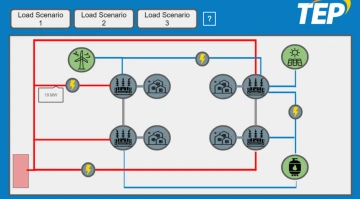Capstone Students Work with TEP to Design the Future of Power Grids

Monsoons or car accidents have the potential to knock down power lines, leaving wide sections of Tucson without electricity. Restoring or rerouting this power can be a complex and time-consuming process. But what if the energy grid could automatically redirect the power?
For their Interdisciplinary Capstone project, six University of Arizona engineering students are working with Tucson Electric Power to build software for an artificial-intelligence-powered energy grid that can automatically redirect power when a line goes down, saving time and lives in the process. They will also design a simulation of Tucson’s energy grid and potential weather patterns.
“To get to that point will require a lot of work, but I truly believe my team is capable of doing the work and solving the issues in this coming semester,” said capstone Team 24039 leader Jamie Newhall, an engineering management major. “This project will also be worked on and improved upon in future years, so we are designing our system to be incredibly modular.”
The ideal outcome for the project is an interactive simulation where users can create different problems for the energy grid. Using a touchscreen TV, the user will click on different power lines and weather scenarios, watching as the system automatically solves the issues to maintain a functioning energy grid. The simulation is planned to also include real-time information on a customer’s energy cost and generation method. This will show how outages impact different areas.
Each member of the capstone team leads a specific focus: Newhall is team leader, Felipe Polanco is the procurement lead, Melany Romero is the research lead, Ian Johnson is the electrical and computer engineering lead, Adam Hoffmeister is the software lead, and Sebastian Govea is the systems lead. However, the students collaborate efficiently by wearing different hats while working on a variety of project elements.

This mockup shows the graphical user interface for the smart energy grid. In the software, users will be able to load different weather and power scenarios to see how they affect the energy grid.
The team has encountered surprising obstacles, such as the wide variety of power lines and how that can impact energy loads, according to Newhall.
“Another, more immediate, issue we faced is learning how to use the simulation software,” Newhall said. “We spent lots of time researching and finding software that, in theory, should fulfill all our requirements. But since none of us has used it before, just trying to learn this software within the limited time that we have has proven to be the largest issue.”
Another “interesting engineering challenge” the team has confronted is deciding what areas of the city and power the AI system will prioritize while rerouting energy. And the team continues to determine how best to balance energy and demand response.
This is an important project as the country makes the transition to alternative sources of electrical power and increases use of electric vehicles, said Steve Larimore, lead instructor for the Interdisciplinary Capstone program.
“Major changes will need to be made to the energy grid, and an accurate simulation will be invaluable to TEP,” he said. “This project should be interesting to everyone who uses electricity – all of us!”

